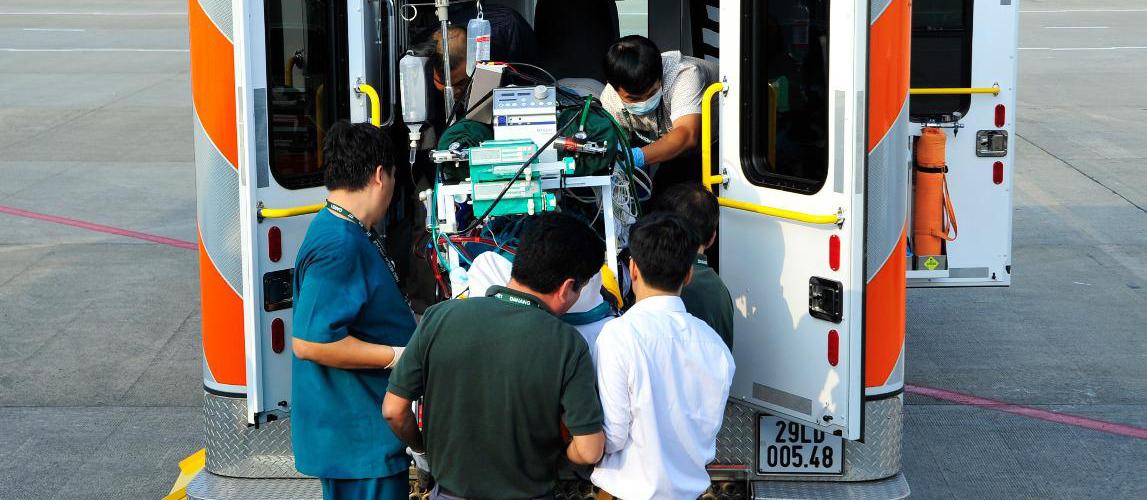Medical Evacuations

Medical evacuations are difficult to pull off, but in terms of complexity, there’s nothing that goes beyond extracorporeal membrane oxidation (ECMO). In these evacuations, a patient needs to be moved from one country to another while their heart is disconnected from their body.
Just like an organ transplant, it takes a team of 12 to 14 people to pull one off, involving a multidisciplinary bioengineering team, a nursing team, and a medical team. The difference is that in an operating theatre, the specialists come and go as they’re needed — while on a plane, they’re all there together, all the time. Anything can go wrong at any moment, and everyone has to rely on their sight because it’s extremely difficult to hear anything over the noise of the engine.
ECMO refers to the action of the heart and lung machine a patient is attached to while their organs are disconnected. ECMO represents the Everest of capacity when it comes to medevacs, with patients who are hanging on a thread between life and death. When a patient reaches an ECMO, it means their heart cannot pump blood any more and it has to be supported by a medical device which imitates the organ’s function. After the heart has been arrested, they will be connected to the machine in the hope that, with some time to rest and heal, things will go back to normal, so the heart can then be reconnected to the body.
Sometimes the patient will need specialized medical attention that is not available in Vietnam; in these cases, he or she must be transferred overseas.
Making the Impossible Possible
Our first ECMO medevac case was a Russian patient who collapsed at Tan Son Nhat Airport. She was rushed to the Heart Center in Saigon, but it was clear that she would need attention from a major facility abroad. At the time, there were no providers in the region who had the capacity to perform an ECMO medevac. Meeting up with her father, who flew in, we explained the situation to him and that this was a complicated procedure which we had never done before. Doable, but risky. Very. I remember her dad saying: “This is my only daughter. It’s a risk for you, but a chance for me.”
With no options available, we decided the only thing we could do was fly the patient out ourselves. Hospitals in Bangkok said they could admit the patient, as long as we found a way to transport her there. Bangkok was the choice as we opted for the shortest route.
We built an entire stretcher with machines on it, wires protruding, oxygen tanks, only to remember we had a patient to insert into all this. The end result was a stretcher with a tower of equipment on top and on both sides. It took five hours to move the patient from her bed and to reconnect her to our systems.
Thanks to Vietnam Airlines, we procured an ATR aircraft, an aircraft with a large cargo door, and together with their technicians we reconfigured the inner part of the plane, leaving an island of chairs in the mid-section for the stretcher to be installed on top, while the support team sat at the back. We took the flight with around five doctors and a nurse. We had a biomedical engineer, who controlled the electricity supply — we had to carry a lot of batteries — plus we also had a lab technician with a portable unit, just in case. We landed in Bangkok having successfully kept the patient well and alive.
The Thai Hospital proved to be another challenge as they had never moved a patient from one ECMO unit to another. Worse, the units were not of the same make. So, over the ensuing three hours, we had to do it for them.
Only on the flight back did we start to grasp the success of the transfer and the implications of it. The patient? She stayed in hospital for three months, survived and returned home.
In Safe Hands
Following this evacuation, we had another from Hanoi to China, and as I write this we’re working on another case. The one thing that makes these cases manageable is that there’s no rush to get from here
to there. While ECMO patients may be holding on by a thread, they’re not dying as long as they’re properly connected to the machine. You can usually wait another couple of days if there’s a delay. Vietnam Airlines have been a tremendous help, and we thank them for their cooperation. We have our agreements with airport authorities; we have our own gates, we have our own evacuation systems; whatever we need to clear.
At our clinic, we now have a highly experienced medical evacuation team and have become regarded as an authority in these matters. Although we started with small cases, we have established Vietnam as one of only seven countries worldwide capable of doing ECMO evacuations.
Dr. Rafi Kot - Founder and CEO, Family Medical Practice
Published in Word Magazine
 We use cookies on this website to enhance your user experience
We use cookies on this website to enhance your user experience